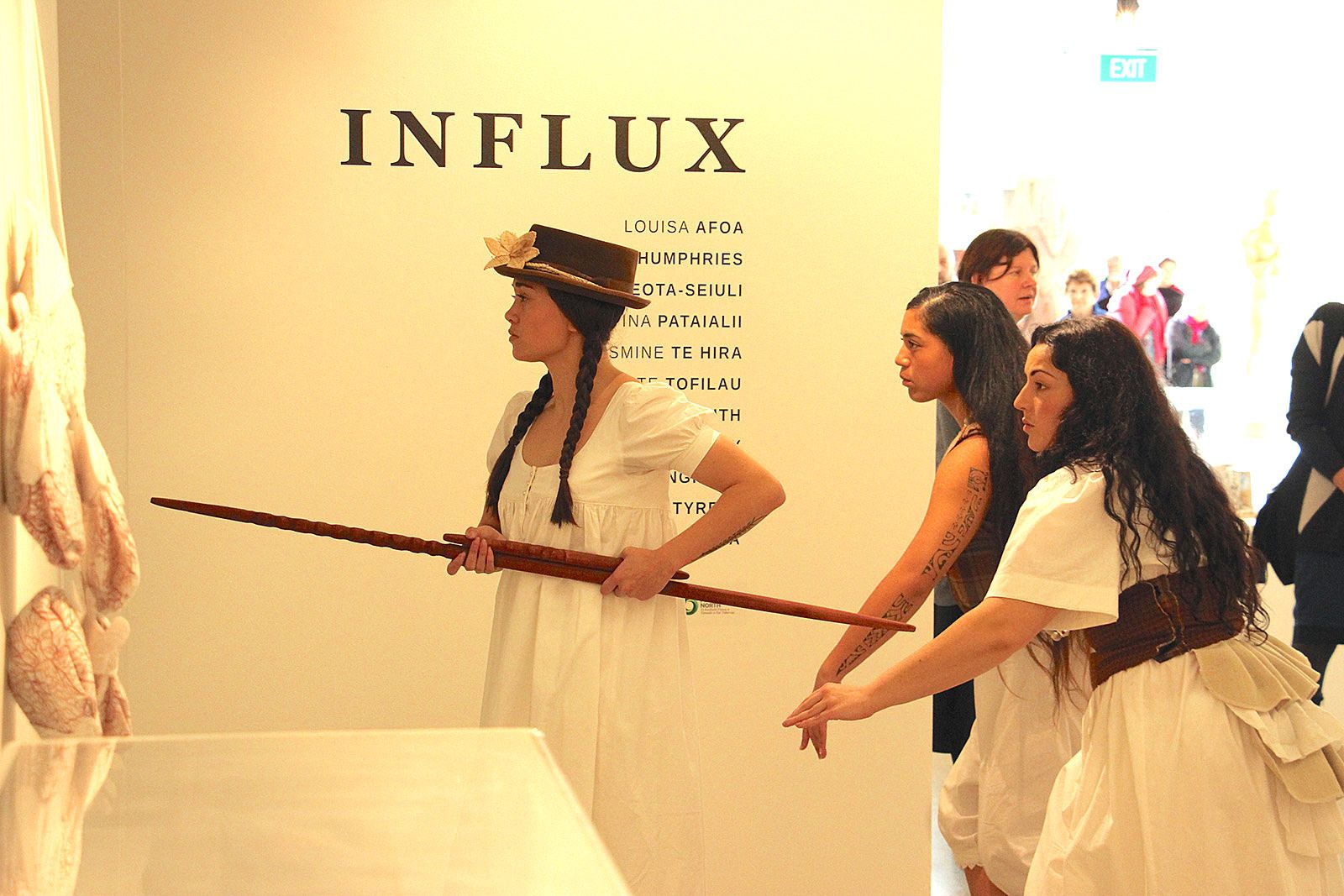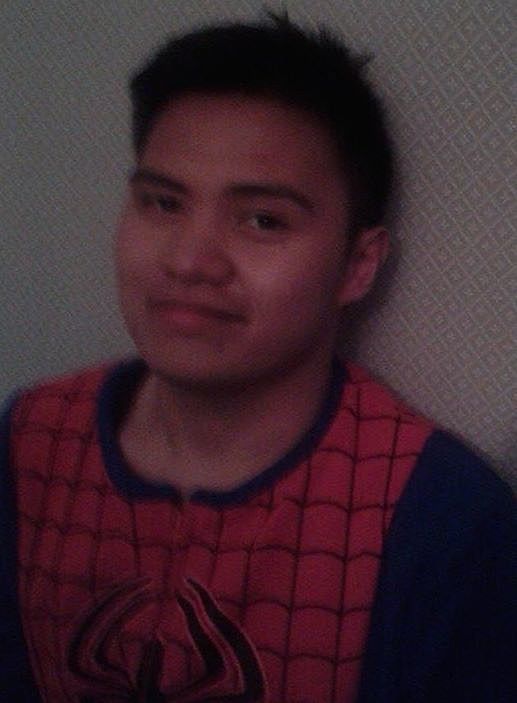Ripping Through the Divide: A Review of Fire in the Water, Fire in the Sky
Matt Loveranes examines Mīria George's latest work, a rumination on place, culture and climate.
Dividing performances between Porirua's Pātaka, and Te Papa, Mīria George's new work as part of Kia Mau Festival ruminates on place, culture and climate. Matt Loveranes reviews the work from its Pātaka season.
Fire in the Water, Fire in the Sky interrogates the changing lives and livelihoods of Indigenous people living by Te Moana-nui-a-kiwa – and how the Western world is distinctly tied to the genesis of this change. It’s no surprise it debuts in Porirua’s Pātaka Art Museum, which asserts itself as a home for contemporary Māori and Polynesian art. It’s worth noting that this isn’t the first time George has chosen this setting for her work; her seminal play And What Remains was originally staged in the Wellington City Gallery.
Pātaka is a space in two halves. Upon entering, you face a long foyer for guests to mill about and a busy café to the right that hums with lively chatter. There’s a korowai exhibit up for Matariki, standing proudly unencumbered by glass protection. To the left and through glass doors, room after room of Māori and Polynesian artefacts and history are kept, and the atmosphere is decidedly more solemn and reserved. There’s a distinct separation between the two spaces, but Fire in the Water, a promenade piece, rips through that divide.
A woman in white (Te Hau Winitana) appears in the foyer unnoticed, rapping two pieces of rākau together, cutting through the white noise of Saturday morning chit-chat. Almost instantly, she changes the space’s energy, slowly and deliberately traversing the length of the foyer, kneeling in reverence before the korowai then settling in front of the doors that guard the other exhibits. Another woman (Manarangi Mua) comes out with a similar white dress but no rākau, performing the same ritual. Finally, a third woman (Mapihi Kelland) emerges, a flower crown on her head, to follow her sisters. Before they enter the exhibition space, they take the time to kneel before each other, eyes connected, movements in sync. They form a pact to tell their story as one.
It’s violent and visceral but eventually the women find their way back to life’s natural rhythm
With their sinuously choreographed movements, these three women embody the simple pleasures, the rituals and the work that dictate the natural order of living in the Islands in a series of interconnected vignettes. When the women enter the new space, the rākau transforms from a musical instrument to a taiaha. They flick their feet back and jerk their heads forward to the natural rhythm of the hunt, but soon enough the effects of Western influence creeps into their lives and slowly alters their axis. The rākau transforms once again, this time into a land tiller, and as Mua slashes the previously untouched soil, the other two women writhe and wriggle on the floor like fish to avoid getting caught. It’s violent and visceral but eventually the women find their way back to life’s natural rhythm, at least until the next wave of Western influence comes.
By the ocean, their hands form the waves that bathe each other. In traversing the deep, they jump over dangerous rocks and coquettishly skip stones. They experience the water fully, in its every exhilarating thrill and peril. In celebration, they sing Enua Manea, a Cook Islands song that exalts the beauty and spirit of Rarotonga. But soon enough they pull out pieces of fabric which read: ‘Tinned Fish Don’t Breed’, ‘Less Puna, More Tuna’, ‘Ban Purse Seining’. All of a sudden, they’re still. No more singing, no more dancing. They wrap their messages around their mouths, silenced.
It’s a trick that’s been done before and will be done again, but its immediacy in cutting through the reverie makes it harrowingly effective. The message is explicit: these techniques are harming the culture and the eco-system beyond repair – and as a result, the lives of the people who inhabit both are ruined. Despite the message itself, it’s the jarring jerk of going from the graceful and welcoming moment to the rigid heaviness of the next that, for me, best exemplifies this tension between cultures. Western influence is a dead weight that stops the natural flow of their dance, the natural flow of life.
Fire in the Water seems most alive and effective when the women are called to be more distinctly human. When they spot another korowai, this time encased in glass, they immediately revere it. Once they finish, though, just like a lot of women after church, the three enjoy a light-hearted gossip. Kelland confides an animated tale about puppy love and heartbreak (in gibberish) and the other two devise a plan to cheer her up. With a glint in her eye, Kelland explodes with energy, hamming up to the audience to distract from the other two trying to steal the glass exhibit. It’s cheeky, irreverent and shows another side to the women than the solemn grace we’ve grown to expect. Most importantly, it literally allows the women to reclaim what was theirs in the first place.
In the last vignette, the women finally speak.
When the women steal a piece of their culture back in a piece performed in a colonised space, alongside other colonised samplings of their culture for people in a Western-influenced country – and especially when their homes, livelihoods and families have been displaced by said colonisation – it’s a gratifying fuck you to their oppressors.
In the last vignette, the women finally speak. We discover rain hasn’t fallen in their whenua for two years, and their talk of a water company draining their land is soaked in panic, fear and apprehension. Though stilted in delivery, the three women evoke this despair in the desperation of their cadences and the urgency in their body language.
The Western world’s overzealous desire for efficiency isn’t the only devastating change that’s racked these women’s lives and the land; the callous and mechanical mining of their resources using pollutive techniques has brought about a menace far more sinister and far-reaching, causing climate change. This irregularity in the natural order gives us all the burden and responsibility of an uncertain future, leaving our children with a world less fruitful, vibrant and healthy than we found it. The people we’ve plundered from are the worst affected, watching the ocean eat their homes.
I can’t help but wish I had more time and more content to dig into. Clocking in at a taut thirty minutes, Fire in the Water, Fire in the Sky effectively conveys the fraught relationship between Western colonisation and the people most grievously affected through truly striking images and lyrical movement.
Like any other piece of art in the museum, it rewards those who invest the time to engage with the piece. Miria George is a singular voice, and presents her work in uncompromising fashion. It may not be the easiest work to engage with for a museum audience seeing it for free, a lot of whom exist within and support the systems of power and exploitation that are the subjects of its indictment, but if it helps a coloniser acknowledge the fault of their actions, the show has done its job. The real test is what we all do next.


